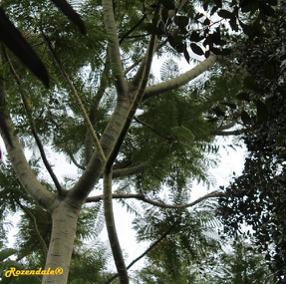Sidebar
Brazilian fern tree - Schizolobium parahybum
Description and Uses
Schizolobium parahybum (Brazilian fern tree) is a tropical tree from Colombia & Venezuela. It is mainly grown for its timber crops (medium shelflife), but also
can be produced. The crop is harvested by total removing. It starts flowering after 2 - 3 years. . Medical uses include; The fresh leaf contains (? - ?). The tree`s wood is called Brazilian ferntree wood and has a density of 320 - 390 kg/m³. Regarding firewood production the tree`s growing speed is very fast, its energetic value is 4513 ckal/kg and the wood`s drying speed is slow; for firewood production it is not ideal. After 10 years the tree can be totally removed as it reached its commercial and ecological goal. Schizolobium parahybum has a lifespan of 45 years.Environmental limitations
It is very fast growing and tolerates not less light than partial shade. Schizolobium parahybum has a shallow root-system and forms symbiotic relations
(endo-mycorrhiza). It is not able to fix nitrogen. The tree`s flower-morphology is androdioecious and is pollinated by bees. Schizolobium parahybum is deciduous in dry season and a bit allelopathic and has no thorns.Schizolobium parahybum thrives in an altitude of 0 to 500 meters above sea-level (tropical). The minimum temperature is 7°C and optimally between 20 - 26°C. The optimal rainfall is 1900 mm/year. Without irrigation the annual rainfall should be between 1000 - 1800 mm (L/m²). The optimal soil-pH is between 6.0 - 7.0 in a soil texture of sand. To salt it is a bit tolerant to wind a bit tolerant and to fire a bit tolerant.
Pests and Diseases
and diseases.
Seed Propagation
Seeds are orthodox and can be stored for 3 months. There are approximative 525 seeds/kg. Unfortunately propagation instruction is missing.
- Botanical Taxonomy -
|
|
|---|---|
| Clade | Rosids |
| Order | Fabales |
| Family | Fabaceae |
| Sub-family | Caesalpinioideae |
| Species | Schizolobium parahybum |
| Common name | Brazilian fern tree |
| Parameter | Rating |
|---|---|
| Fruit | 1.00 |
| Nut | 1.00 |
| Apiculture | 3.00 |
| Fodder | 3.00 |
| Medicinal | 3.00 |
| Oil | 0.00 |
| Timber | 3.00 |
| Firewood | |
| Grow-speed | very fast |
See also |
|
|---|---|
Completed species |
|
|---|---|
|
|
|





